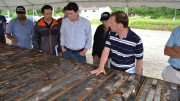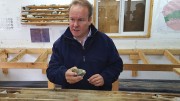KENO CITY, YUKON — Rolling into Alexco Resource’s (TSX: AXR; NYSE-MKT: AXU) Keno Hill silver camp outside of the long-standing — though now sparsely populated — mining hamlet of Keno City in the central Yukon is a living lesson in history. The local museum houses industrial relics and antique equipment that tell the silent stories of a half-century of large-scale silver production that ended in the late 1980s, while Alexco’s modern camp is juxtaposed by the fading remnants of the empty town of Elsa.
Alexco’s goal since acquiring the land package in 2006 has been to revive the prolific district, and it hopes that a pair of discoveries will pave the way to sustainable production. The company took a brief run at restarting operations in 2011 when it began pulling ore from the Bellekeno silver mine, but by 2013 it had announced the “interim suspension of operations,” due to rising operating costs and falling silver prices.
During a walk through Alexco’s quiet flotation mill, president and CEO Clynton Nauman says that the real upside for Keno Hill has always been exploration, and the company’s geological team has never stopped combing the 230 sq. km district for discoveries.
In fact, Alexco nearly built its processing facility on top of its next potential source of mill feed, the Flame & Moth deposit, which the company found while shutting down operations three years ago.
We leave the mill and Nauman points out preliminary work on a portal to develop the first 25 metres of a new underground production ramp.
Flame & Moth hosts indicated resources of 1.4 million tonnes grading 516 grams silver per tonne, 0.42 gram gold per tonne, 1.7% lead and 5.7% zinc. Contained silver is nearly 23 million ounces. Mineralization comprises multi-phase quartz and siderite veining, developed within a broad host fault structure. Locally it contains massive galena, sphalerite, pyrite and pyrrhotite, with associated silver sulphosalts, arsenopyrite and chalcopyrite.
“Our focus has been on the eastern end of the district, and we believe it is the key to restarting production,” Nauman says. “Our Bellekeno mine is located there, and we had expected Flame & Moth to anchor future operations because it appears to be a much larger deposit. So we were proceeding with that plan and everything was going well, but around one year ago we came across Bermingham.”
During a drive up Galena Hill, vice-president of exploration Alan McOnie pulls up in front of the historic portal to the prolific Hector-Calumet mine, which cranked out 96 million oz. silver during its life at an average grade of 1,214 grams silver per tonne.
Bermingham sits 1 km southwest of the old mine workings up a winding gravel road, which is blanketed by a dense fog on the day of The Northern Miner’s visit. Alexco previously outlined a small resource on the deposit, but due to relatively “lower grades and complicated geology” it had turned its attention towards Flame & Moth.
That all changed in late 2015, however, when drilling cut nearly 5 metres of 7,462 grams silver at Bermingham in hole 15-580.

Alexco Resource’s idled flotation mill, which was originally commissioned at 407 tonnes per day to produce both lead and zinc concentrates. Photo by Matthew Keevil.
The company devised an 8,000-metre follow-up drill program, which rose to 17,000 metres after results confirmed and expanded the high-grade Bear zone, including a recent intercept of 7.5 metres at 2,715 grams silver from hole 16-608.
Current resources are contained within the Etta and Arctic zones, and total 377,000 indicated tonnes grading 430 grams silver for 5.2 million contained ounces.
“The tenor and continuity of the mineralization, plus the continuing thickness of the high-grade zone as we drill deeper, are really exciting,” McOnie shouts over the metallic rumble of a nearby drill rig.
“Plus our understanding of the vein geometry — including finding mineralized parallel and conjugate veins — seems to tell us that we’re looking at a mineralization pattern similar to the largest deposits in the district, including Hector-Calumet,” he adds.
The Bear zone is characterized by complex silver-bearing mineral assemblages, including: pyrargyrite (“ruby silver”), freibergite, silver-bearing galena, stephanite, polybasite and “wire silver” in a dominantly sideritic gangue.
“It has all the earmarks that have indicated other major deposits discovered around Keno Hill. Bermingham has delayed our restart plans because we really need to see where this thing goes,” Nauman adds. “But even if it goes nowhere, what’s been outlined is of strategic importance to the way that we develop this district. In the last month or so, we are starting to figure this out. And at this point, we’re preparing to move forward again.”
Alexco’s quest to resume production is also underpinned by the recent rally in precious metal markets. Silver prices have rebounded from below US$15 per oz. in late 2015 to nearly US$19 per oz. at press time. The company does have a financial complication, however, due to a streaming agreement with Silver Wheaton (TSX: SLW; NYSE: SLW) signed in 2008.
Silver Wheaton bought 25% of life-of-mine payable silver produced from the Keno Hill district for US$50 million in cash, plus unit payments tied to the prevailing market silver price. In mid-2014, the companies slightly amended the agreement to “increase the production payment to be a function of the silver price,” but it still encompasses all current and future discoveries by Alexco in the district. Alexco hopes to further renegotiate the agreement to boost potential operating margins.
“We wouldn’t be here today without Silver Wheaton, and their team recognized before anyone else that [Keno Hill] is truly underexplored. They invested money in Alexco really early, literally on the back of our initial exploration work,” Nauman says. “The recent discoveries are proving we were all right about the prospectivity, and Silver Wheaton has been open in discussing the options available to get the operation back up and running.”
Alexco hopes to release a preliminary economic assessment by year-end that incorporates its work at Flame & Moth. It intends to finish hydrological well drilling, metallurgical testing and waste-rock characterization studies to support permitting activity.
Restarting operations would involve a “multi-mine” plan that would include the Bellekeno, Lucky Queen and Flame & Moth deposits.
Nauman added, however, that Alexco wants to advance Bermingam as “quickly as realistically possible.”
In May Alexco closed a $13-million, non-brokered private placement wherein it issued 10.8 million units priced at $1.20 apiece. Each unit includes a share and a warrant exercisable at $1.75 for two years. The company reported $25 million in net working capital in September.
Alexco shares have traded in a 52-week range of 35¢ to $3.31 per share, and closed at $2.43 at press time. There are 69.5 million shares outstanding for a $214-million market capitalization.
“We’re really in the unique position of hitting production with minimal capital costs, and we have a high-grade resource developing at Bermingham,” Nauman said. “I’d caution it’s still at the discovery stage and there is plenty of work to do, but assuming we continue to see strength in the silver market, we’ll be well-positioned to look closely at redeveloping Keno Hill as we move into the new year. There are also other promising targets in the Bermingham area that offer similar geological potential, and I’d expect looking at those in 2017.”






Be the first to comment on "Site visit: Alexco hopes Bermingham will drive Keno Hill revival"